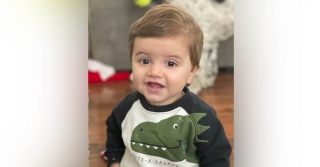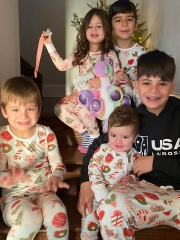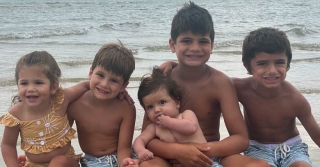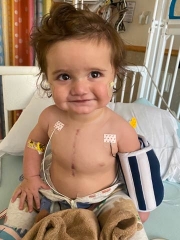Transposition of the Great Arteries: Mazan’s Story
Published on
Published on
Chelsea works as a perinatal sonographer in the Lehigh Valley in eastern PA. When Chelsea became pregnant with her fifth child, she was concerned about the history of placental abruption in her previous two pregnancies. However, her ultrasound showed something completely unexpected: her son had a heart defect
 Chelsea and her husband, Edward, were seen by Louis Hansrote, MD, FAAP, FAAC, of Children’s Hospital of Philadelphia’s Allentown Cardiac Center, and referred to CHOP’s Fetal Heart Program, where Jack Rychik, MD, Medical Director of the Fetal Heart Program, confirmed the baby’s diagnosis. Mazan had transposition of the great arteries (TGA), ventricular septal defect and pulmonary valve stenosis. In babies with TGA, the two large arteries that carry blood from the heart are connected to the heart on the wrong sides, causing these infants to have dangerously low blood oxygen levels. These babies typically require urgent intervention immediately after birth, and all will eventually require open-heart surgery.
Chelsea and her husband, Edward, were seen by Louis Hansrote, MD, FAAP, FAAC, of Children’s Hospital of Philadelphia’s Allentown Cardiac Center, and referred to CHOP’s Fetal Heart Program, where Jack Rychik, MD, Medical Director of the Fetal Heart Program, confirmed the baby’s diagnosis. Mazan had transposition of the great arteries (TGA), ventricular septal defect and pulmonary valve stenosis. In babies with TGA, the two large arteries that carry blood from the heart are connected to the heart on the wrong sides, causing these infants to have dangerously low blood oxygen levels. These babies typically require urgent intervention immediately after birth, and all will eventually require open-heart surgery.
At CHOP, babies born with this and other congenital heart defects may be referred to the Richard D. Wood Jr. Center for Fetal Diagnosis and Treatment and delivered in the Garbose Family Special Delivery Unit (SDU), enabling expert cardiac care right after delivery. Mazan was born in the SDU on Dec. 15, 2021.
 Mazan with his siblings
Surprisingly, Mazan’s heart was stable upon delivery, and he was able to breathe almost entirely on his own. After a week in the hospital, his care team was considering discharge when Mazan’s stats began to change, and his oxygen levels decreased.
Mazan with his siblings
Surprisingly, Mazan’s heart was stable upon delivery, and he was able to breathe almost entirely on his own. After a week in the hospital, his care team was considering discharge when Mazan’s stats began to change, and his oxygen levels decreased.
CHOP doctors performed a balloon atrial septostomy, a lifesaving catheterization procedure which creates or enlarges a hole between the upper chambers of the heart, allowing more oxygen-rich blood to get to the body.
Though he would need surgery in the very near future, Mazan was temporarily discharged to spend some time at home and followed by Robert Palermo, DO, FACC, a pediatric cardiologist in CHOP’s Allentown Cardiac Center, just 15 minutes from the family’s home.
At 3 months, Mazan returned to CHOP, for his first surgery with cardiothoracic surgeon Katsuhide Maeda, MD, PhD. Dr. Maeda placed a Blalock-Thomas-Taussig (BTT) shunt, which is a small tube connecting the arterial circulation to the pulmonary circulation, allowing more blood to flow to the lungs. A temporary solution, the BTT shunt would allow Mazan to grow and better prepare for his future surgery, the arterial switch.
With Chelsea’s medical background, knowing the severity of Mazan’s condition left her feeling helpless.
“We didn’t know the extent of recovery,” says Edward. “Seeing Mazan come out of surgery [after the BTT shunt operation] with wires and IVs was really hard.”
 Although Mazan’s surgery was successful, his recovery was difficult. He spent two weeks in the hospital, during which Chelsea and Edward had to commute to the hospital so they could also attend to their four other children. “It was hard not to be under one roof,” says Chelsea.
Although Mazan’s surgery was successful, his recovery was difficult. He spent two weeks in the hospital, during which Chelsea and Edward had to commute to the hospital so they could also attend to their four other children. “It was hard not to be under one roof,” says Chelsea.
Mazan finally returned home, only to be readmitted a week later with the flu.
The biggest challenge, however, was feeding Mazan. He needed to gain weight in preparation for the arterial switch but had difficulty keeping food down. In addition, Mazan’s low oxygen made him too lethargic to eat. “It was like he was having to choose whether to eat or breathe,” says Edward.
“Even though we felt overwhelmed with the struggle of trying to get Mazan to eat and gain weight,” says Chelsea, “Dr. Palermo was there to answer any questions we had. He always let us know that, though it was difficult, we were all doing great.”
As Mazan neared his first birthday, his care team agreed they could no longer wait for surgery. He was beginning to have episodes of cyanosis (turning blue), and his oxygen remained in the low 80s. Three weeks before his birthday, Mazan returned to CHOP for surgery. Dr. Maeda performed a Rastelli operation in which the pink blood entering the left ventricle is channeled towards the aorta from the right ventricle, and a conduit is placed from the right ventricle cavity to the vessels to the lungs.
“We were nervous, but this time we were prepared for a long recovery,” says Edward. “We expected another round of feeding issues.”
 Chelsea and Edward were thrilled when, instead of the difficulty they’d experienced after the previous surgery, Mazan eagerly accepted a bottle one day post-op. Now able to breathe properly, “he wanted to eat everything in sight,” says Chelsea.
Chelsea and Edward were thrilled when, instead of the difficulty they’d experienced after the previous surgery, Mazan eagerly accepted a bottle one day post-op. Now able to breathe properly, “he wanted to eat everything in sight,” says Chelsea.
Recovering from his second surgery in less than a week, Mazan was soon able to return home, where he quickly began eating solid foods. “It was like he was a different child,” says Edward.
Mazan will eventually outgrow the conduit and will likely need a pulmonary valve replacement when his heart reaches its adult size.
For now, he continues to be followed by Dr. Palermo, and his parents are grateful for the convenient proximity of the Allentown Cardiac Center to their home.
“Nobody likes driving into the city,” says Chelsea. “I now don’t have to plan my whole day around that drive.”
Mostly, however, the family is grateful to have received the exceptional care of their cardiac team. Says Chelsea, “Even though it was such a hard situation, the amount of love, support and care we’ve received from Dr. Palermo and his practice has been unreal.”
Now 18 months, Mazan loves to play with his older siblings, dance, play hide-and-seek and most of all — eat!